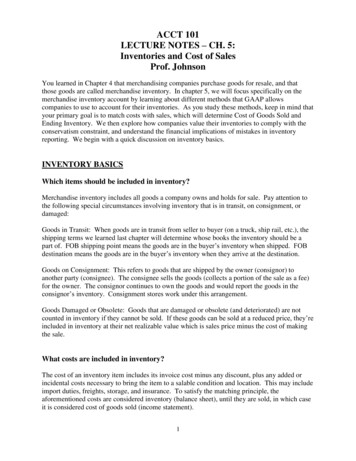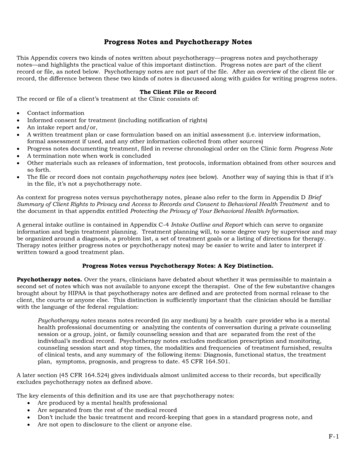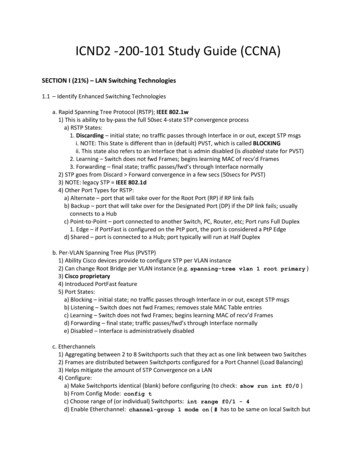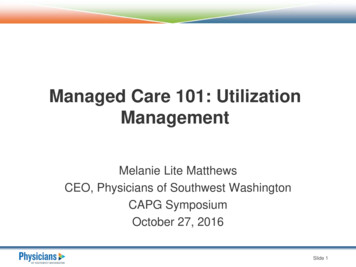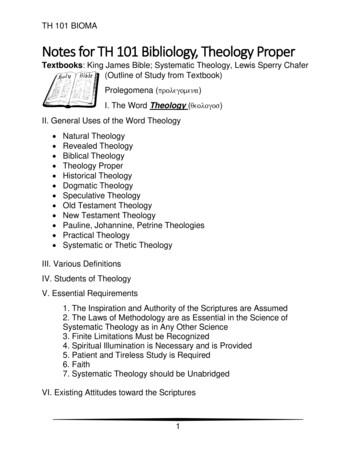
Transcription
TH 101 BIOMANotes for TH 101 Bibliology, Theology ProperTextbooks: King James Bible; Systematic Theology, Lewis Sperry Chafer(Outline of Study from Textbook)Prolegomena (prolegomena)I. The Word Theology (qeologos)II. General Uses of the Word Theology Natural TheologyRevealed TheologyBiblical TheologyTheology ProperHistorical TheologyDogmatic TheologySpeculative TheologyOld Testament TheologyNew Testament TheologyPauline, Johannine, Petrine TheologiesPractical TheologySystematic or Thetic TheologyIII. Various DefinitionsIV. Students of TheologyV. Essential Requirements1. The Inspiration and Authority of the Scriptures are Assumed2. The Laws of Methodology are as Essential in the Science ofSystematic Theology as in Any Other Science3. Finite Limitations Must be Recognized4. Spiritual Illumination is Necessary and is Provided5. Patient and Tireless Study is Required6. Faith7. Systematic Theology should be UnabridgedVI. Existing Attitudes toward the Scriptures1
TH 101 BIOMA1. Rationalisma. Extremeb. Moderate2. Mysticisma. False Mysticismb. True Mysticism3. Romanism4. The Orthodox Protestant FaithVII. Major Divisions of Systematic Theology1. Bibliology (bibliologos)2. Theology Proper3. Angelology (angelologos)4. Anthropology (anqropologoj)5. Soteriology (soteriologoj)6. Ecclesiology (ekklesiologoj)7. Eschatology (escatologoj)8. Christology (cristologoj)9. Pneumatology (pneumatologoj)10. Doctrinal SummarizationConclusionBibliologyI. The Supernatural Origin of the Bible1. The Book of God2. The Bible and Monotheism3. The Doctrine of the Trinitya. God the Fatherb. God the Sonc. God the Holy Spirit4. Creation5. Sin6. The Cure of Evil according to the Bible2
TH 101 BIOMA7. The Extent of Bible Revelation8. The Ethics of the Bible9. The Continuity of the Bible10. Prophecy and its Fulfillment11. Types with their Antitypes12. The Bible as Literature13. The Bible and Science14. The Bible and Temporal Power15. The Bible’s Enduring FreshnessII. General Divisions of the Bible1. The Structure Of The Bible2. Created Beings And Their Relationshipsa. The Angelsb. The Gentilesc. The Jewsd. The Christians3. Time Periods Of The Biblea. Divisions Related To Humanity(1.) The First Period(2.) The Second(3.) The Third(4.) The Fourth Periodb. Dispensations(1.) The Dispensation Of Innocence(2.) The Dispensation Of Conscience(3.) The Dispensation Of Human Government(4.) The Dispensation Of Promise(5.) The Dispensation Of Law(6.) The Dispensation Of Grace(7.) The Dispensation Of Kingdom Rulec. The Covenants(1.) The Covenant Of Redemption(2.) The Covenant Of Works(3.) The Covenant Of Grace(4.) The Edenic Covenant(5.) The Adamic Covenant(6.) The Noahic Covenant(7.) The Abrahamic Covenant(8.) The Mosaic Covenant3
TH 101 BIOMA(9.) The Palestinian Covenant(10.) The Davidic Covenant(11.) The New Covenant For The Church(12.) The New Covenant For Israeld. Prophetic Periods(1.) From Adam To Abraham(2.) From Abraham To Moses(3.) From Moses To Daniel(4.) From Daniel To Christ(5.) From The First To The Second Advent Of Christ(6.) From The Beginning To The End Of The Millennial(7.) Kingdom(8.) The Eternal Statee. The Various Aspects Of The Earthly Kingdom(1.) The Theocracy(2.) The Kingdom Promised(3.) The Kingdom Anticipated By The Prophets(4.) The Kingdom Announced As “At Hand”(5.) The Mystery Form Of The Kingdom(6.) The Kingdom To Be Re-Announced By The 144,000in Final Anticipation Of Messiah’s Return(7.) The Kingdom In Manifestationf. The Divisions Of The Scriptures Relative To The History OfIsrael In The Landg. The Divisions Of The Scriptures Relative To The Gentiles(1.) As Outside The Jewish Covenants AndCommonwealth Privileges(2.) As Receiving A Dispensation Of World Rule At TheHour Of Israel’s Last Dispersion(3.) As Now Privileged To Receive The Gospel Of DivineGrace(4.) As Brought Into Judgment At The End Of TheirDispensation Of World Rule(5.) As Seen In Prophecy(6.) As Entering And Continuing In Israel’s Kingdom(7.) As Partakers In The Glory Of The Celestial Cityh. Divisions Of The Scripture Relative To The Church(1.) As Seen In Types(2.) As Anticipated Directly In Prophecy4
TH 101 BIOMA(3.) As Being Called Out From, And Yet Resident, In TheWorld(4.) As Distinct From Judaism(5.) As Caught Into Heaven By Resurrection AndTranslation(6.) As Returning With Christ To His Earthly Reign(7.) As Reigning With Christ On Earth(8.) As Partakers In Glory Of The New Heaven4. Main Divisions Of BibliologyIII. Revelation1. Three Important Doctrines Distinguisheda. Revelation And Reasonb. Revelation And Inspirationc. Revelation, Inspiration, And Illumination2. The Nature Of Revelationa. God Revealed Through Natureb. God Revealed Through Providencec. God Revealed Through Preservationd. God Revealed Through Miraclese. God Revealed Through Direct Communicationf. God Revealed Through The Incarnationg. God Revealed Through The Scriptures3. Divine Revelation Is Varied In Its Themesa. Divine Revelation Is Partial Concerning The Facts Revealedb. Divine Revelation Is Completec. Divine Revelation Is Progressived. Divine Revelation Is Primarily Unto Redemptione. Divine Revelation Is Finalf. Divine Revelation Is Accurate To The Point Of InfinityIV. Inspiration1. The Fact And Importance Of Inspirationa. Christ Versus The Apostlesb. Accommodationc. Ignoranced. Contradiction2. Theories Of Inspirationa. The Mechanical Or Dictation Theoryb. Partial Inspirationc. Degrees Of Inspiration5
TH 101 BIOMAd. The Concept And Not The Words Inspirede. Natural Inspirationf. Mystical Inspirationg. Verbal, Plenary Inspiration3. Dual Authorship4. God’s Word About God’s Word5. General Objections To Verbal, Plenary Inspiration6. ConclusionV. Canonicity and Authority1. The Scriptures Are Authoritative Being God-Breathed2. The Scriptures Are Authoritative Being Written By Chosen MenWho Were “Borne Along” By The Holy Spirit3. The Scriptures Are Authoritative Being Accredited By Those WhoFirst Received Them4. The Scriptures Are Authoritative Being Attested By The Lord JesusChrist-The Second Person Of The Godhead5. The Scriptures Are Authoritative Being Received, Delivered, AndAttested By The Prophetsa. The Congregation’s Relation To The Scripturesb. The King’s Relation To The Scripturesc. The Official’s Relation To The Scripturesd. The Levites’ Relation Scripturese. The Prophets’ Relation To The Scriptures6. The Scriptures Are Authoritative Being The Word Employed ByGod The Holy Spirit7. The Authority Of The Bible Is Seen In The Fact That Without TheSlightest Deflection It Vindicates And Satisfies Every Claima. Enduring Powerb. Imperial Powerc. Sanctifying Powerd. Revealing Powere. Accuracyf. Prevailing Powerg. Prophecy8. ConclusionVI. Illumination1. Specific Forms Of Spiritual Darknessa. Israel’s Blindnessb. Gentile Darkness6
TH 101 BIOMAc. Satanic Darknessd. Carnal Blindness2. The Illuminating Work Of The Holy SpiritVII. Interpretation1. The Purpose Of The Bible As A Whole2. The Distinctive Character And Message Of Each Book Of TheBible3. To Whom Is A Given Scripture Addressed?4. Consideration Of The Context5. Consideration Of All Scripture Bearing On Any Given Theme6. Discovery Of The Exact Meaning Of The Determinative Words OfThe Text7. The Necessity Of Avoiding Personal PrejudicesVIII. Animation1. The Power Of God’s Word Upon The Unsaved2. The Power Of God’s Word Upon The SavedIX. PreservationTheology ProperI. Introduction to Theological Proper1. Intuition2. Traditiona. The Remoteb. The Present3. Reasona. The Intrinsic Valueb. The Achievements4. RevelationII. Naturalistic Theism1. The Cosmological Argument2. The Teleological Argument3. The Anthropological Argument4. The Ontological Argument5. ConclusionIII. Antitheistic Theism1. Atheism2. Agnostic3. Evolution7
TH 101 BIOMA4. Materialism5. Polytheism6. Idealism and Realism7. Pantheism8. Deism9. Positivism10. Monism11. Dualism12. Pluralism13. ConclusionIV. Biblical Theism1. The Personality of Goda. The Personality of God2. The Attributes of Goda. Personality(1.) Omniscience(2.) Sensibility(a.) Holiness(b.) Justice(c.) Love(d.) Goodness(e.) Truth(3.) Will(a.) Freedom(b.) Omnipotentb. Constitutional Attributes(1.) Simplicity(2.) Unity(3.) Infinity(4.) Eternity(5.) Immutability(6.) Omnipresence or Immensity(7.) Sovereigntyc. Conclusion3. Divine Decreesa. The Decree of God(1.) Two Basic Problems(a.) The Essential Nature of Sin(b.) The Permission of Sin8
TH 101 BIOMA(2.) The Problem of the Willb. Predestination(1.) Election(2.) Retributionc. Objections to the Doctrine of Divine Decree(1.) The Justice of God(2.) The Love of God(3.) Predestination Predetermines that Men shall Sin(4.) Predestination the Means to its Ends(5.) Predestination and Gospel Preaching(6.) Predestination and Fatalism(7.) Divine Decree and Human Sufferingd. Major Manifestations of the Divine Decree(1.) Creation(2.) The Program of the Ages(3.) Preservation(4.) Providence(5.) Prayer(6.) Miracles(7.) Gracee. Conclusion4. The Names of Deitya. The Primary Names of Deity in the Old Testament(1.) Jehovah(2.) Elohim(3.) Adon, Adonaib. Compoundsc. Old Testament Epithetsd. New Testament Namese. ConclusionVII. Trinitarianism1. Introduction to Trinitarianisma. Preliminary Considerationb. Three Dishonors(1.) Christ(2.) The Holy Spirit(3.) The Scripturesc. General Definitiond. The True Emphasis9
TH 101 BIOMA2. Proof of Trinitarian Doctrinea. Reason(1.) The Divine Attributes are Eternal(2.) Eternal Activity of the Attributes(3.) The Attributes Require Both Agent and Object(4.) God is Sufficient in Himself(5.) The Agent and Object are Person(6.) Plurality in God is a Trinity(7.) The Bible Sustains Reason(a.) The External Exercise of Love(b.) The Exercise of Mutual Glory(c.) The Exercise of Knowing(d.) The Exercise of Divine Disposition toCommunionb. Revelation(1.) The Doctrine of the Trinity as Set Forth in the OldTestament(2.) The Doctrine of the Trinity as Set Forth in the NewTestament(a.) The Trinity and the Names of God(b.) The Trinity and the Attributes of God(3.) The Trinity and the Works of God(a.) Creation of the Universe(b.) Creation of Man(c.) The Incarnation(d.) The Life and Ministry of Christ(e.) The Death of Christ(f.) The Resurrection of Christ(g.) The Resurrection of All Mankind(h.) The Inspiration of the Scriptures(i.) The Minister’s Authority(j.) The Indwelling Presence(k.) The Work of Sanctification(l.) The Believer’s Safekeeping(4.) The Trinity and Worship of God(a.) By Angels(b.) By Saints(c.) The Benedictions10
TH 101 BIOMAVIII. God the Father1. Fatherhood Over Creation2. Fatherhood by Intimate Relationship3. The Father of Our Lord Jesus Christ4. Fatherhood Over All Who BelieveIX. God the Son: His Pre-existence1. Major Passages on Pre-existence2. The Angel of Jehovaha. A Divine Personb. Part of the TrinityX. God the Son: His Names1. Jehovah, LORD2. Elohim, God3. Son of God, Son of Man4. Lord Jesus ChristXI. God the Son: His Deity1. Divine Attributes Belong to Christa. Eternityb. Immutabilityc. Omnipotenced. Omnisciencee. Omnipresencef. Other Major Attributes2. The Prerogatives of Deity are Ascribed to Christa. He is the Creator of All Thingsb. He is Preserver of All Thingsc. He Pardons Sind. Christ Will Raise the Deade. Christ Apportions the Rewards of Saintsf. The Judgment of the World is Committed to Christg. That Worship Which Belongs Only to God is FreelyRendered to Christ3. ObjectionsXII. God the Son: His Incarnation1. Who Became Incarnate?2. How did the Son Become Incarnation?3. For What Purpose Did He Become Incarnate?a. That He Might Manifest God to Manb. That He Might Manifest Man to God11
TH 101 BIOMAc. That He Might Be a Merciful and Faithful High Priestd. That He Might Destroy the Works of the Devile. That He Might Be Head Over the New Creationf. That He Might Sit On David’s Throneg. That He Might Be a Kinsman Redeemer4. ConclusionXIII. God the Son: His Humanity1. Christ’s Humanity Was Anticipated Before the Foundation of theWorld2. The Old Testament Expectation was of a Human Messiaha. The Typesb. Prophecy3. A Specific New Testament Prophecy4. The Life of Christ on Eartha. His Namesb. His Human Parentagec. The Fact that He Possessed a Human Body, Soul, and Spiritd. His Human Limitations5. The Death and Resurrection of Christ6. The Humanity of Christ is Seen in His Ascension and Session7. The Humanity of Christ is Evident in His Second Advent andKingdom ReignXIV. God the Son: The Kenosis1. “The Form of God”2. The Condescension3. “The Form of a Servant the Likeness of Men”4. ConclusionXV. God the Son: The Hypostatic Union1. The Structure of the Doctrinea. His Deityb. His Humanityc. The Complete Preservation of Each of His Two Natureswithout Confusion or Alteration of Them and Their Unity2. The Relationshipsa. To the Fatherb. To the Spiritc. To Himselfd. To Angels Unfallen and Fallene. To Humanity12
TH 101 BIOMAf. To Sin and the Sin Nature(1.) The Impeccability of Christg. To Those Who are Saved3. ConclusionXVI. God the Holy Spirit1. The Personality of the Holy Spirit2. The Deity of the Holy Spirita. The Holy Spirit is Called Godb. The Holy Spirit is Associated With Godc. The Attributes of God are Predicated of the Holy Spiritd. The Holy Spirit May be Blasphemed3. The Witness of the Old Testamenta. The Holy Spirit in Comical Undertakingsb. The Holy Spirit’s Work in Things Governmentalc. The Holy Spirit in Relation to Individuals4. The Witness of the New Testament5. His Titles6. His Relationshipsa. To the Fatherb. To the Sonc. To the Worldd. To the Fleshe. To the Devilf. To Christiansg. To the Divine Purpose7. His Adorable Character8. Conclusion13
TH 101 BIOMA 1 Notes for TH 101 Bibliology, Theology Proper Textbooks: King James Bible; Systematic Theology, Lewis Sperry Chafer (Outline of Study from Textbook) Prolegomena (prolegom

